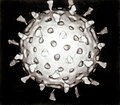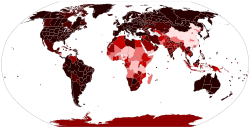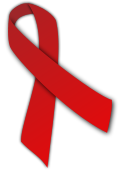Portal:Viruses
The Viruses Portal
Welcome!

Viruses are small infectious agents that can replicate only inside the living cells of an organism. Viruses infect all forms of life, including animals, plants, fungi, bacteria and archaea. They are found in almost every ecosystem on Earth and are the most abundant type of biological entity, with millions of different types, although only about 6,000 viruses have been described in detail. Some viruses cause disease in humans, and others are responsible for economically important diseases of livestock and crops.
Virus particles (known as virions) consist of genetic material, which can be either DNA or RNA, wrapped in a protein coat called the capsid; some viruses also have an outer lipid envelope. The capsid can take simple helical or icosahedral forms, or more complex structures. The average virus is about 1/100 the size of the average bacterium, and most are too small to be seen directly with an optical microscope.
The origins of viruses are unclear: some may have evolved from plasmids, others from bacteria. Viruses are sometimes considered to be a life form, because they carry genetic material, reproduce and evolve through natural selection. However they lack key characteristics (such as cell structure) that are generally considered necessary to count as life. Because they possess some but not all such qualities, viruses have been described as "organisms at the edge of life".
Selected disease
Herpes simplex is caused by herpes simplex virus types 1 and 2 of the Herpesviridae family, with 60–95% of adults being infected with one of the types. Common forms of infection are oral herpes, which can result in cold sores, and genital herpes. Active disease often involves blisters containing infectious virus, although the genital form is frequently asymptomatic. Less common disorders associated with the viruses include herpetic whitlow, herpes gladiatorum, ocular herpes, herpesviral encephalitis and Mollaret's meningitis.
After initial infection, virus particles are transported along sensory nerves to the cell bodies in the ganglion, where they become latent and remain lifelong. Periods of remission alternate with outbreaks of active disease, in which the virus multiplies in the nerve cell and new virus particles are transported along the nerve fibre to the nerve terminals in the skin, where they are released. What causes these recurrences is unclear. Transmission is usually by direct contact with a lesion or with body fluids, and can occur during periods of asymptomatic shedding. Neonatal herpes is possible after transmission from the mother. Barrier protection methods reduce genital herpes risk. No vaccine or cure exists, but antiviral treatment can alleviate symptoms and reduce viral shedding.
Selected image
The antiviral fomivirsen was the first antisense therapy to be licensed by the FDA. It binds to a cytomegalovirus mRNA and is used to treat cytomegalovirus retinitis.
Credit: Fvasconcellos (1 January 2007)
In the news
26 February: In the ongoing pandemic of severe acute respiratory syndrome coronavirus 2 (SARS-CoV-2), more than 110 million confirmed cases, including 2.5 million deaths, have been documented globally since the outbreak began in December 2019. WHO
18 February: Seven asymptomatic cases of avian influenza A subtype H5N8, the first documented H5N8 cases in humans, are reported in Astrakhan Oblast, Russia, after more than 100,0000 hens died on a poultry farm in December. WHO
14 February: Seven cases of Ebola virus disease are reported in Gouécké, south-east Guinea. WHO
7 February: A case of Ebola virus disease is detected in North Kivu Province of the Democratic Republic of the Congo. WHO
4 February: An outbreak of Rift Valley fever is ongoing in Kenya, with 32 human cases, including 11 deaths, since the outbreak started in November. WHO
21 November: The US Food and Drug Administration (FDA) gives emergency-use authorisation to casirivimab/imdevimab, a combination monoclonal antibody (mAb) therapy for non-hospitalised people twelve years and over with mild-to-moderate COVID-19, after granting emergency-use authorisation to the single mAb bamlanivimab earlier in the month. FDA 1, 2
18 November: The outbreak of Ebola virus disease in Équateur Province, Democratic Republic of the Congo, which started in June, has been declared over; a total of 130 cases were recorded, with 55 deaths. UN
Selected article
A global drive to eradicate poliovirus started in 1988, when there were an estimated 350,000 cases of wild poliovirus infection globally. Two diseases, both caused by viruses, have been eradicated, smallpox in 1980 and rinderpest in 2011. Poliovirus only infects humans. It persists in the environment for a few weeks at room temperature and a few months at 0–8 °C. The oral polio vaccine is inexpensive, highly effective and is predicted to generate lifelong immunity. Reversion of live vaccine strains to virulence has resulted in occasional cases of vaccine-associated polio paralysis.
Two of the three strains of wild-type poliovirus have been eradicated. Annual reported cases of wild poliovirus infection fell to a low of 22 in 2017, but had risen to 176 in 2019. As of 2020, the wild virus remains endemic only in Afghanistan and Pakistan, but vaccine-derived poliovirus is circulating in several countries. A lack of basic health infrastructure and civil war remain significant obstacles to eradication. Some local communities have opposed immunisation campaigns, and vaccination workers have been murdered in Pakistan and Nigeria.
Selected outbreak
The 2009 flu pandemic was an influenza pandemic first recognised in Mexico City in March 2009 and declared over in August 2010. It involved a novel strain of H1N1 influenza virus with genes from five different viruses, which resulted when a previous triple reassortment of avian, swine and human influenza viruses further combined with a Eurasian swine influenza virus, leading to the term "swine flu" being used for the pandemic. It was the second pandemic to involve an H1N1 strain, the first being the 1918 "Spanish flu" pandemic.
The global infection rate was estimated as 11–21%. This pandemic strain was less lethal than previous ones, killing about 0.01–0.03% of those infected, compared with 2–3% for Spanish flu. Most experts agree that at least 284,500 people died, mainly in Africa and Southeast Asia – comparable with the normal seasonal influenza fatalities of 290,000–650,000 – leading to claims that the World Health Organization had exaggerated the danger.
Selected quotation
| “ | There are more viruses on Earth than stars in the universe. | ” |
Recommended articles
Viruses & Subviral agents: bat virome • elephant endotheliotropic herpesvirus • HIV • introduction to viruses![]() • Playa de Oro virus • poliovirus • prion • rotavirus
• Playa de Oro virus • poliovirus • prion • rotavirus![]() • virus
• virus![]()
Diseases: colony collapse disorder • common cold • croup • dengue fever![]() • gastroenteritis • Guillain–Barré syndrome • hepatitis B • hepatitis C • hepatitis E • herpes simplex • HIV/AIDS • influenza
• gastroenteritis • Guillain–Barré syndrome • hepatitis B • hepatitis C • hepatitis E • herpes simplex • HIV/AIDS • influenza![]() • meningitis
• meningitis![]() • myxomatosis • polio
• myxomatosis • polio![]() • pneumonia • shingles • smallpox
• pneumonia • shingles • smallpox
Epidemiology & Interventions: 2007 Bernard Matthews H5N1 outbreak • Coalition for Epidemic Preparedness Innovations • Disease X • 2009 flu pandemic • HIV/AIDS in Malawi • polio vaccine • Spanish flu • West African Ebola virus epidemic
Virus–Host interactions: antibody • host • immune system![]() • parasitism • RNA interference
• parasitism • RNA interference![]()
Methodology: metagenomics
Social & Media: And the Band Played On • Contagion • "Flu Season" • Frank's Cock![]() • Race Against Time: Searching for Hope in AIDS-Ravaged Africa
• Race Against Time: Searching for Hope in AIDS-Ravaged Africa![]() • social history of viruses
• social history of viruses![]() • "Steve Burdick" • "The Time Is Now" • "What Lies Below"
• "Steve Burdick" • "The Time Is Now" • "What Lies Below"
People: Brownie Mary • Macfarlane Burnet![]() • Bobbi Campbell • Aniru Conteh • people with hepatitis C
• Bobbi Campbell • Aniru Conteh • people with hepatitis C![]() • HIV-positive people
• HIV-positive people![]() • Bette Korber • Henrietta Lacks • Linda Laubenstein • Barbara McClintock
• Bette Korber • Henrietta Lacks • Linda Laubenstein • Barbara McClintock![]() • poliomyelitis survivors
• poliomyelitis survivors![]() • Joseph Sonnabend • Eli Todd • Ryan White
• Joseph Sonnabend • Eli Todd • Ryan White![]()
Selected virus
Poliovirus is an enterovirus, an RNA virus in the Picornaviridae family, associated with the paralytic disease polio. The icosahedral virus particle is about 30 nanometres in diameter and lacks an envelope. It contains a relatively short, single-stranded positive RNA genome of around 7500 nucleotides, which encodes about ten viral products. The virus has a fairly high mutation rate even for an RNA virus. Historically there were three serotypes, each with a slightly different capsid protein; PV1 is the most common, and PV2 was declared eradicated in 2015.
The virus only naturally infects humans, although some monkeys can be infected experimentally; 95% of infections are asymptomatic. Infection occurs via the faecal–oral route and viral replication occurs in the alimentary tract. The virus enters the host cell by binding to an immunoglobulin-like receptor, CD155. Fully assembled poliovirus leaves the cell 4–6 hours after initiation of infection. Poliovirus was first isolated in 1909 by Karl Landsteiner and Erwin Popper. Its genome was sequenced in 1981. Among the simplest clinically significant viruses, poliovirus is one of the best-characterised viruses, and has become a useful model for studying RNA viruses.
Did you know?
- ...that the hairpin ribozyme (pictured) is an RNA that can encode genetic information and catalyse biological reactions?
- ...that in the 1980s British physician John R. Seale advocated the theory that HIV might have been created in a germ warfare laboratory?
- ...that the Visna virus, a retrovirus that causes encephalitis and chronic pneumonitis in sheep, is used as a model system for HIV infection?
- ...that Thomas C. Peebles, who went on to isolate the measles virus strain used in the measles vaccine, was initially rejected by Harvard Medical School because he had gotten a D in college biology?
- ...that studies in phage ecology indicate that viruses may be the most abundant organisms on Earth?
Selected biography
Many well-known people have survived the paralytic disease polio. The earliest identified case might be Siptah (pictured), Egyptian pharaoh 1197–1191 BC, whose mummified remains have a deformed leg possibly from polio. Claudius, Roman emperor 41–54 AD, walked with a limp after a childhood disease that historians have hypothesised might have been polio. Novelist Sir Walter Scott suffered paralysis in one leg after a teething fever in 1773, which left him lame; his detailed account of his disease has allowed a retrospective diagnosis of polio to be made with confidence.
For many of those who survived it, paralytic polio was a life-changing experience. The disease can lead to permanent physical disability; Itzhak Perlman, for example, plays the violin seated. Others recover completely, with some going on to excel in sports; Ray Ewry became world's foremost standing jumper after childhood polio. Some survivors, including singer Ian Dury and actress Mia Farrow, have campaigned for polio eradication or for disability rights.
In this month
5 June 1981: First report of HIV/AIDS (symbol pictured) appeared in medical literature
6 June 1997: Gene silencing in plants shown to be a viral defence mechanism
7–13 June 1962: Donald Caspar and Aaron Klug proposed the quasi-equivalence principle of virus structure
7–13 June 1962: André Lwoff proposed a viral classification scheme based on nature of genome, type of symmetry and presence of envelope
7–13 June 1962: George Hirst proposed that the influenza virus genome is segmented
9 June 1981: The American Society for Virology was founded
13 June 2012: First case of Middle East respiratory syndrome coronavirus (MERS-CoV) occurred in Saudi Arabia
18 June 1981: A vaccine against foot-and-mouth disease was the first genetically engineered vaccine
21 June 1996: Nevirapine approved, first NNRTI for HIV/AIDS
26 June 1993: Clinical trial of hepatitis B virus drug fialuridine terminated; the drug caused several fatalities due to lactic acidosis
28 June 2011: FAO declared rinderpest eradicated
30 June 1985: Ryan White was denied re-admittance to his school after an AIDS diagnosis, in a case that changed public perceptions of the disease
Selected intervention
Influenza vaccines include live attenuated and inactivated forms. Inactivated vaccines contain three or four different viral strains selected by the World Health Organization to cover influenza A H1N1 and H3N2, as well as influenza B, and are usually administered by intramuscular injection. The live attenuated influenza vaccine contains a cold-adapted strain and is given as a nasal spray. Most influenza vaccine strains are cultivated in fertilised chicken eggs (pictured), a technique developed in the 1950s; others are grown in cell cultures, and some vaccines contain recombinant proteins. Annual vaccination is recommended for high-risk groups and, in some countries, for all those over six months. As the influenza virus changes rapidly by antigenic drift, new versions of the vaccine are developed twice a year, which differ in effectiveness depending on how well they match the circulating strains. Despite considerable research effort for decades, no effective universal influenza vaccine has been identified. A 2018 meta-analysis found that vaccination in healthy adults decreased confirmed cases of influenza from about 2.4% to 1.1%. However, the effectiveness is uncertain in those over 65 years old, one of the groups at highest risk of serious complications.
Subcategories
Subcategories of virology:
Topics
Things to do
- Comment on what you like and dislike about this portal
- Join the Viruses WikiProject
- Tag articles on viruses and virology with the project banner by adding {{WikiProject Viruses}} to the talk page
- Assess unassessed articles against the project standards
- Create requested pages: red-linked viruses | red-linked virus genera
- Expand a virus stub into a full article, adding images, citations, references and taxoboxes, following the project guidelines
- Create a new article (or expand an old one 5-fold) and nominate it for the main page Did You Know? section
- Improve a B-class article and nominate it for Good Article
 or Featured Article
or Featured Article status
status - Suggest articles, pictures, interesting facts, events and news to be featured here on the portal
WikiProjects & Portals
 WikiProject Viruses
Related WikiProjects
WikiProject Viruses
Related WikiProjects
Medicine • Microbiology • Molecular & Cellular Biology • Veterinary Medicine
Related PortalsAssociated Wikimedia
The following Wikimedia Foundation sister projects provide more on this subject:
-
Commons
Free media repository -
Wikibooks
Free textbooks and manuals -
Wikidata
Free knowledge base -
Wikinews
Free-content news -
Wikiquote
Collection of quotations -
Wikisource
Free-content library -
Wikispecies
Directory of species -
Wikiversity
Free learning tools -
Wiktionary
Dictionary and thesaurus




















